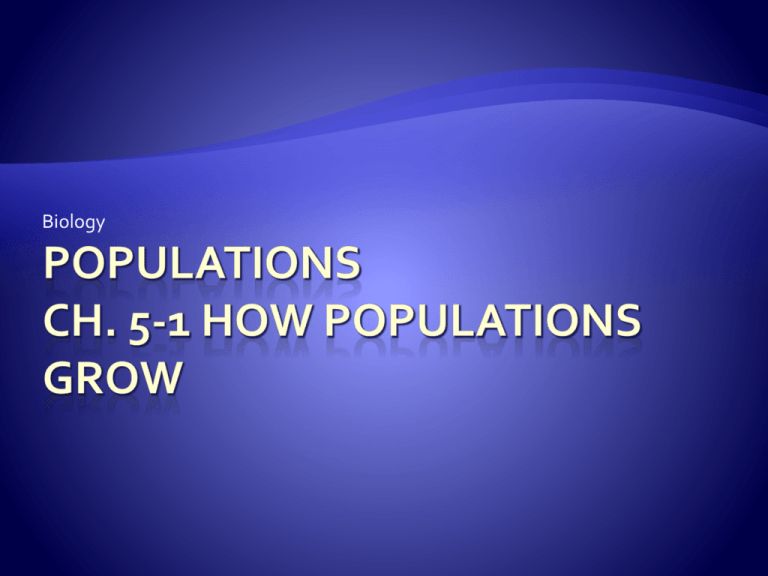
Biology
Three important
characteristics of a
population are its:
geographic distribution
density
growth rate
Copyright Pearson Prentice Hall
Geographic distribution, or range, describes the
area inhabited by a population.
Population density is the number of individuals
per unit area.
Growth rate is the increase or decrease of the
number of individuals in a population over time.
Copyright Pearson Prentice Hall
Three factors can affect
population size:
number of births
number of deaths
number of individuals
that enter or leave the
population
A population can grow
when its birthrate is
greater than its death
rate.
http://knowledge.allianz.com/nopi_downloads/images/demographic%20change_global%20
population_96dpi_1.jpg
Copyright Pearson Prentice Hall
Immigration, the movement of individuals into
an area, is another factor that can cause a
population to grow.
Populations can increase by immigration as
animals in search of mates or food arrive from
outside.
Copyright Pearson Prentice Hall
Emigration, the movement of individuals out of
an area, can cause a population to decrease in
size.
Emigration can occur when animals leave to find
mates and establish new territories.
A shortage of food in one area may also lead to
emigration.
Copyright Pearson Prentice Hall
Under ideal conditions with unlimited resources, a population
will grow exponentially.
Exponential growth occurs when the individuals in a
population reproduce at a constant rate.
The population becomes larger and larger until it approaches
an infinitely large size.
Copyright Pearson Prentice Hall
In nature, exponential growth does not continue
in a population for very long.
As resources become less available, the growth
of a population slows or stops.
Logistic growth occurs
when a population's
growth slows or stops
following a period of
exponential growth.
Copyright Pearson Prentice Hall
Carrying Capacity
The largest number of individuals of a population that a
given environment can support is called its carrying
capacity.
When a population reaches the carrying capacity of its
environment, its growth levels off. The average growth
rate is zero.
Copyright Pearson Prentice Hall
Population density is the number of individuals
a) that are born each year.
b) per unit area.
c) that immigrate.
d) that emigrate.
Copyright Pearson Prentice Hall
When the birthrate of a population exceeds its death
rate, the population
a)
b)
c)
d)
decreases.
increases.
stays the same.
increases then decreases.
Copyright Pearson Prentice Hall
An S-shaped curve on a graph of population growth is
characteristic of
a)
b)
c)
d)
exponential growth.
logistic growth.
carrying capacity.
delayed growth.
Copyright Pearson Prentice Hall
Exponential growth in a population slows down or stops
as
a)
b)
c)
d)
resources become limited.
rate of immigration increases.
rate of emigration decreases.
birth rate increases.
Copyright Pearson Prentice Hall
Exponential growth rate means that each new
generation of a population
a) adds the same number of new individuals as the
previous generation did.
b) increases at the same rate as the previous generation.
c) is the same size as the generation before.
d) increases by a varying amount.
Copyright Pearson Prentice Hall
Biology
Copyright Pearson Prentice Hall
The primary productivity of an ecosystem can be
reduced when there is an insufficient supply of a
particular nutrient.
Ecologists call such substances limiting nutrients.
Copyright Pearson Prentice Hall
A limiting nutrient is an example of a more
general ecological concept: a limiting factor.
In the context of populations, a limiting factor is
a factor that causes population growth to
decrease.
Copyright Pearson Prentice Hall
A limiting factor that
depends on population
size
Density-dependent
limiting factors include:
competition
predation
parasitism
disease
Copyright Pearson Prentice Hall
http://i.telegraph.co.uk/telegraph/multimedia/archive/00796/crowdedbritain_796405c.jpg
Density-dependent factors operate only when
the population density reaches a certain level.
These factors operate most strongly when a
population is large and dense.
They do not affect small, scattered populations
as greatly.
Copyright Pearson Prentice Hall
Competition
When populations become crowded, organisms
compete for food, water space, sunlight and other
essentials.
Competition among members of the same species is a
density-dependent limiting factor.
Copyright Pearson Prentice Hall
Competition can also occur between members of
different species.
This type of competition can lead to evolutionary
change.
Over time, the species may evolve to occupy
different niches.
Copyright Pearson Prentice Hall
Predation
Populations in nature are often controlled by
predation.
The regulation of a population by predation takes
place within a predator-prey relationship, one of the
best-known mechanisms of population control.
Copyright Pearson Prentice Hall
Wolf and Moose Populations on Isle Royale
Copyright Pearson Prentice Hall
Parasitism and Disease
Heart worms
Parasites can limit the
growth of a population.
A parasite lives in or on
another organism (the
host) and consequently
harms it.
http://ucdnema.ucdavis.edu/imagemap/nemmap/ent156html/slides/fromCD/1939/56
B.GIF
Copyright Pearson Prentice Hall
Affect all populations in
similar ways, regardless of
the population size.
Examples of densityindependent limiting
factors include:
unusual weather
natural disasters
seasonal cycles
certain human activities—
such as damming rivers and
clear-cutting forests
Copyright Pearson Prentice Hall
http://www.stuffintheair.com/images/clear-cutting-21135550.jpg
A limiting factor that affects all populations in similar
ways regardless of their size might be
a)
b)
c)
d)
drought.
disease.
predation.
crowding.
Copyright Pearson Prentice Hall
Which of the following would be a limiting factor
affecting the panda population of China?
a) programs that educate people about endangered
species
b) capture of some pandas for placement in zoos
c) laws protecting habitat destruction
d) a disease that kills bamboo plants
Copyright Pearson Prentice Hall
Density-dependent factors operate most strongly when
a population is
a)
b)
c)
d)
large and dense.
large but sparse.
small and sparse.
small, but growing.
Copyright Pearson Prentice Hall
Within a limited area, if the population of a predator
increases, the population of its prey is likely to
a)
b)
c)
d)
increase.
decrease.
remain about the same.
become extinct.
Copyright Pearson Prentice Hall
Which of the following is a density-independent factor
affecting populations?
a)
b)
c)
d)
predation
disease
a destructive hurricane
parasites
Copyright Pearson Prentice Hall








